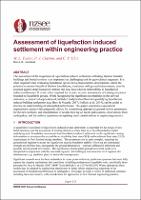The Assessment of Liquefaction induced Settlement - application within Engineering Practice

Download
Date
2021-04-14Authors
Taylor, Merrick
Clayton, Phil
Chin, C Y
Metadata
Show full item recordAbstract
The assessment of the magnitude of liquefaction-induced settlements affecting shallow founded buildings and buried services is an important yet challenging task for geotechnical engineers. It is often required when assessing foundation options for a proposed new development, where the potential economic benefit of shallow foundations must be assessed against their higher vulnerability to liquefaction induced settlements. It constitutes an important part of the decision-making process when expensive ground improvement treatments are proposed to ensure adequate performance for sensitive structures. It is also often required for detailed seismic assessments of existing structures on liquefiable ground, to ascertain whether the magnitude of ground movements would constitute either a 'geotechnically dominated' or at least an 'interactive' assessment where the behaviour may determine the %NBS rating according to the NZSEE guidelines. A careful application of the analytical methods available for quantifying liquefaction induced building settlements (e.g. Bray & Macedo, 2017; Bullock et al., 2019) is required to develop an understanding of the expected performance, under the multiple seismic hazard levels corresponding to the respective design limit states (i.e., serviceability, operational continuity, repairability, and ultimate). This paper summarises assessment requirements and provides pragmatic advice for determining appropriate ground motion parameters for the new methods, and interpretation of results drawing on recent publications, observations from earthquakes, and the authors experience in applying these considerations in engineering practice.
